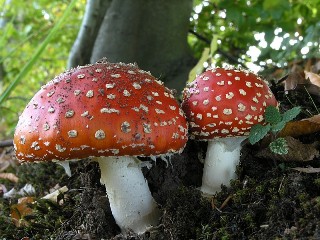
Nutrition
-
A. muscaria has many nutritional characteristics in common with all members of the Fungi Kingdom:
1. Like animals, A. muscaria is heterotrophic, meaning it acquires nutrients by
consuming organic material. This is one characteristic that helped scientists
determine that fungi are more closely related to animals than plants.
2. Unlike animals, A. muscaria digests its food prior to ingestion. This is accomplished
via exoenzymes that are synthesized in the endoplasmic reticulum and transported to
the hyphal tips in vesicles. Upon fusion with the membrane, the vesicle dumps the
exoenzymes on to the substrate. The exoenzymes then degrade that substrate into
smaller molecules that can be by the hyphae.
3. Under conditions where food sources are abundant, A. muscaria stores sugars as
glycogen, another similarity between fungi and animals.
-
The most important nutritional characteristic that A. muscaria possesses has to be the symbiotic relationship it forms with trees known as ectomycorrhizae. This is a characteristic found throughout the phyla Basidiomycota. Through this relationship, both A. muscaria and the host tree benefit. The host supplies A. muscaria with sugars produced via photosynthesis. In return, A. muscaria provides the host with increased surface area to increase its water uptake and aids the roots in absorption of vital nutrients such as phosphorous and nitrogen. I will go into more detail about ectomycorrhizae and its structure in in the adaptations page.
But before we look at the adaptations A. muscaria has developed, take a look at the methods it uses for Reproduction.
